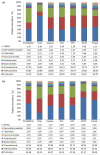Assessment of soil bacterial communities in integrated crop production systems within the Amazon Biome, Brazil: a comparative study
- PMID: 38696039
- PMCID: PMC11405747
- DOI: 10.1007/s42770-024-01352-8
Assessment of soil bacterial communities in integrated crop production systems within the Amazon Biome, Brazil: a comparative study
Abstract
Integrated production systems have been proposed as alternative to sustainable land use. However, information regarding bacterial community structure and diversity in soils of integrated Crop-Livestock-Forest systems remains unknown. We hypothesize that these integrated production systems, with their ecological intensification, can modulate the soil bacterial communities. However, Yet, it remains unclear whether the modulation of bacterial biodiversity is solely attributable to the complexity of root exudates or if seasonal climatic events also play a contributory role. The objective of this study is to evaluate the impact of monoculture and integrated production systems on bacterial soil communities in the Amazon Biome, Brazil. Three monoculture systems, each with a single crop over time and space (Eucalyptus (E), Crop Soybean (C), Pasture (P)), and three integrated systems with multiple crops over time and space (ECI, PI, ECPI) were evaluated, along with a Native forest serving as a reference area. Soil samples were collected at a depth of 0-10 cm during both the wet and dry seasons. Bacterial composition was determined using Illumina high-throughput sequencing of the 16 S rRNA gene. The sequencing results revealed the highest abundance classified under the phyla Firmicutes, Actinobacteria, and Proteobacteria. The Firmicutes correlated with the Crop in the rainy period and in the dry only ECPI and Forest. For five classes corresponding to the three phyla, the Crop stood out with the greatest fluctuations in their relative abundance compared to other production systems. In cluster analysis by genus during the rainy season, only Forest and ECPI showed no similarity with the other production systems. However, in the dry season, both were grouped with Forest and EPI. Therefore, the bacterial community in integrated systems proved to be sensitive to management practices, even with only two years of use. ECPI demonstrated the greatest similarity in bacterial structure to the Native forest, despite just two years of experimental deployment. Crop exhibited fluctuations in relative abundance in both seasons, indicating an unsustainable production system with changes in soil microbial composition. These findings support our hypothesis that integrated production systems and their ecological intensification, as exemplified by ECPI, can indeed modulate soil bacterial communities.
Keywords: 16S rRNA sequencing; Illumina; Integrated crop-livestock-forest; Tropical forest biodiversity.
© 2024. The Author(s) under exclusive licence to Sociedade Brasileira de Microbiologia.
Figures




References
-
- FAO (Food and Agriculture Organization) of the United Nations (2012) Agriculture and consumer protection department. Conservation agriculture, http://www.fao.org/nr/cgrfa/cthemes/cgrfa-microorganisms
-
- Alves RT, Bateman RP (2013) Evaluation of formulation and volume application rate on the secondary pick-up of Metarhizium acridum (Driver & Milner) Bischoff, Rehner & Humber conidia on Schistocerca gregaria (Forskål) (Orthoptera: Acrididae) BioAssay. 8, 4
-
- Santos CC, Oliveira FA, Santos MS, Talamini V, Ferreira JMS, Santos FJ (2012) Influência de Trichoderma spp. sobre o crescimento micelial de Thielaviopsis paradoxa. Scientia Plena 8(4):1–5
-
- Tonin RFB, Reis EM, Delli ALD (2013) Etiologia E quantificação Dos agentes causais de manchas foliares na cultura do trigo nas safras 2008 a 2011. Summa Phytopathol 39(2):102–109
-
- Alvarenga RC, Porfirio-da-Silua V, Gontijo Neto M, Machado MC, Vilela L (2010) Sistema Integração lavoura-Pecuária-Floresta: condicionamento do solo e intensificação da produção de lavouras. Informe Agropecuário, Belo Horizonte, v.31, n.257, pp. 59–67
Publication types
MeSH terms
Substances
LinkOut - more resources
Full Text Sources
Research Materials
Miscellaneous

